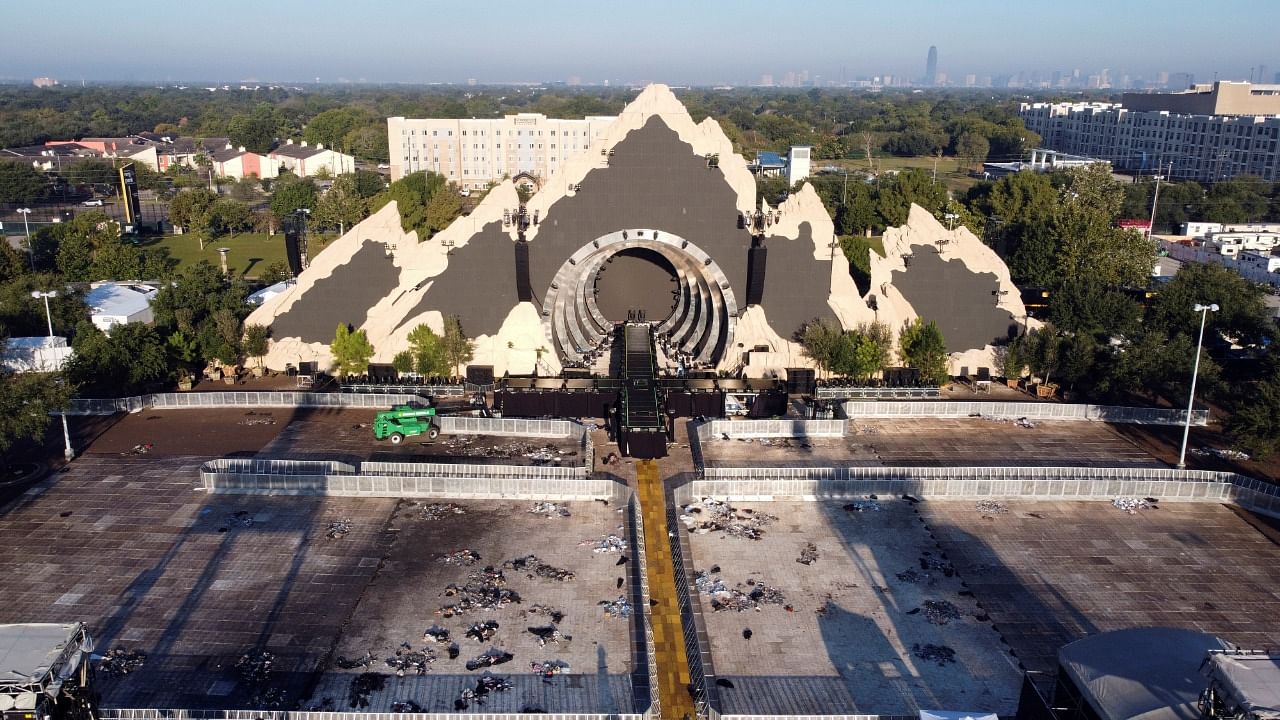
Emergency plans for the Astroworld music festival did not include protocols for dangerous crowd surges like the one that unfolded during a rush to see headliner Travis Scott, which left eight people dead and injured hundreds of others, including a 9-year-old boy whose family said was in a coma.
The concert area in Houston where a crush of fans had pressed forward during the rapper's Friday night performance remains largely in place as authorities continue a criminal investigation. More than 20 lawsuits have already been filed, accusing organisers of failing to take simple crowd-control steps or staff properly.
Houston police, along with the fire department, played a key role in safety measures at the sold-out show that drew 50,000 people. The union head of the Houston Fire Department pushed back Tuesday, saying firefighters did not have a presence inside the festival and were not given radios to communicate directly with organisers.
Hundreds of people were treated for injuries on-site and at least 13 were hospitalised. They included a 9-year-old boy who attended the festival with his father but became separated as the crowd became dangerously packed, according to family members.
Bernon Blount said his grandson, Ezra, was in a medically induced coma on Tuesday at a Houston hospital and that the boy's heart, lungs and brain were injured in the melee.
“My son, once he had passed out from the pressure being applied to him during the concert, he passed out and Ezra fell into the crowd,” Blount told The Associated Press. “When my son awakened, Ezra wasn't there.”
A 56-page event operations plan for the Astroworld music festival included protocols for dangerous scenarios including an active shooter, bomb or terrorist threats and severe weather. But it did not include information on what to do in the event of a crowd surge.
“In any situation where large groups of people are gathering, there is the potential for a civil disturbance/riot that can present a grave risk to the safety and security of employees and guests,” the plan said.
“The key in properly dealing with this type of scenario is proper management of the crowd from the minute the doors open. Crowd management techniques will be employed to identify potentially dangerous crowd behaviour in its early stages in an effort to prevent a civil disturbance/riot.”
Experts say crowd surge deaths happen because people are packed into a space so tightly that they are being squeezed and can't get oxygen. It's not usually because they're being trampled.
Authorities have said part of their investigation will include reviewing whether the concert promoter and others behind the festival adhered to the plans submitted.
Marty Lancton, president of the Houston Professional Fire Fighters Association, said firefighters had asked festival organisers for a radio so they could be in direct contact with each other. Lancton said firefighters were given a list of cellphone numbers to call during an emergency.
“We don't use cellphones for emergencies. We use radios. We need direct contact because as situations unfold, seconds matter,” Lancton said.
He said a group of four firefighters were stationed inside a mobile command van in a nearby parking lot starting at 7 am on Friday. Without direct communication with the festival organisers, the firefighters inside the van monitored six different radio frequencies to keep tabs on what was going on, he said.
Festival organisers had contracted with New York-based ParaDocs to handle all medical services at the festival. A 22-page plan the company submitted to local officials ahead of the festival said it estimated 70,000 attendees — more than the actual number of concertgoers — and planned for a daily staff of more than 80 emergency medics, doctors, registered nurses and supervisors.
ParaDocs said in a statement Tuesday the company had been “prepared for the size of the venue and the expected audience with a trained team of medics and EMT" and that it was cooperating with investigators.
Houston police and fire department investigators have said they are reviewing surveillance video provided by concert promoter Live Nation, as well as dozens of clips from people at the show that were widely shared on social media.
Scott, who founded the Astroworld festival, said he would cover funeral costs for the victims. The dead ranged in age from 14 to 27 and came from Texas, Illinois and Washington state, according to Harris County authorities. They included high schoolers, an aspiring Border Patrol agent and a computer science student.
Astroworld's event operations and emergency medical response protocols filed with Harris County and obtained by the AP states “the potential for multiple alcohol/drug related incidents, possible evacuation needs, and the ever-present threat of a mass casualty situation are identified as key concerns.”
The festival was held on a parking lot that is part of NRG Park, a complex that consists of stadiums, an arena and a convention centre.
Attorneys representing those injured or killed during the festival were granted access to the event's grounds on Tuesday to inspect and photograph the site. Ryan MacLeod, who is representing several people hurt during the concert, said the area around where Scott had his concert seemed to have no place for people to exit once they went in.
There is a long history of similar catastrophes at concerts, as well as sporting and religious events. In 1979, 11 people were killed as thousands of fans tried to get into Cincinnati's Riverfront Coliseum to see a concert by The Who.
Other crowd catastrophes include the deaths of 97 people at a soccer match in Hillsborough Stadium in 1989 in Sheffield, England, and numerous disasters connected with the annual hajj pilgrimage in Saudi Arabia.
Check out DH's latest videos: